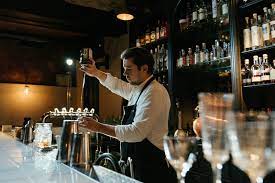Designing Delight: The Impact of Interior Design on Cafe Atmosphere and Customer Engagement

Introduction:
In the bustling world of cafes, where patrons seek more than just a cup of coffee, interior design plays a pivotal role in shaping the atmosphere and enhancing customer engagement. From cozy nooks to trendy hangouts, the ambiance of a cafe can significantly influence the overall dining experience. In this article, we delve into the profound impact of interior design on cafe atmosphere and customer engagement, exploring key elements, trends, and strategies to create inviting and immersive spaces.
The Significance of Cafe Interior Design:
Cafe interior design goes beyond mere aesthetics; it is about creating inviting atmospheres that entice and delight customers. The layout, decor, and furnishings of a cafe contribute to its ambiance, setting the stage for memorable dining experiences. Whether it’s a quaint neighborhood cafe or a chic urban bistro, the interior design sets the tone for the overall dining experience, influencing customer perceptions and behaviors.
1. Creating Memorable Experiences: Cafe interior design sets the stage for memorable experiences for patrons. From the moment customers walk through the door, the ambiance, decor, and layout contribute to their overall impression and enjoyment of the space. Thoughtfully designed cafes can leave a lasting impact, enticing customers to return for more than just a cup of coffee.
2. Reflecting Brand Identity: Cafe interior design serves as a visual representation of the brand’s identity and values. Whether it’s a cozy neighborhood cafe or a trendy urban hotspot, the design elements should align with the brand’s personality and target demographic. From the choice of furniture to the color palette and decor, every aspect of the interior design communicates a message about the cafe’s unique identity.
3. Enhancing Comfort and Relaxation: A well-designed cafe creates an inviting and comfortable atmosphere where customers can relax and unwind. Comfortable seating, cozy lighting, and soothing music contribute to a welcoming ambiance that encourages patrons to linger longer. By prioritizing customer comfort, cafe owners can foster a sense of loyalty and create a loyal customer base.
4. Encouraging Social Interaction: Interior design for cafes plays a crucial role in facilitating social interaction and community engagement. Thoughtfully arranged seating areas, communal tables, and cozy corners encourage patrons to strike up conversations, share ideas, and connect with others. A well-designed cafe becomes a social hub where people come together to enjoy good company, making it an integral part of the community fabric.
5. Driving Business Success: Ultimately, the significance of cafe interior design lies in its ability to drive business success. A visually appealing and well-designed cafe attracts customers, encourages repeat visits, and generates positive word-of-mouth recommendations. By investing in interior design that enhances the overall dining experience, cafe owners can differentiate themselves from competitors, increase customer satisfaction, and ultimately, boost profitability.
Interior Design for Cafes: Key Elements and Considerations:
Designing cozy cafe spaces requires careful attention to detail and a deep understanding of customer preferences. Comfortable seating, warm lighting, and pleasing aesthetics are essential elements that contribute to a welcoming ambiance. Additionally, factors such as layout optimization, acoustics, and ventilation play crucial roles in creating a comfortable and enjoyable dining environment for customers.
Interior design for cafes goes beyond simply arranging furniture and choosing color schemes; it’s about crafting a space that enhances the overall dining experience. Following guide will explore the key elements and considerations that contribute to creating inviting and memorable cafe environments.
1. Layout Optimization: The layout of a cafe is critical in maximizing space efficiency and creating a comfortable flow for customers. Consider factors such as table placement, traffic flow, and seating arrangements to ensure that the space is both functional and inviting. A well-designed layout encourages movement and interaction while also providing options for privacy and intimacy.
2. Comfortable Seating: Comfort is paramount in a cafe setting, as customers often spend extended periods enjoying their coffee or meals. Choose seating options that are both stylish and comfortable, such as plush armchairs, cozy banquettes, or ergonomic bar stools. Cushions and upholstery should be durable and easy to clean to maintain a welcoming atmosphere.
3. Lighting Design: Lighting sets the mood and ambiance of a cafe, influencing everything from customer behavior to food presentation. Natural light is ideal whenever possible, but strategically placed artificial lighting can also enhance the atmosphere. Consider a mix of ambient, task, and accent lighting to create layers of illumination that complement the space and highlight key design elements.
4. Aesthetic Appeal: The aesthetic of a cafe should reflect its brand identity and target demographic. Whether it’s rustic and cozy, modern and minimalist, or eclectic and vibrant, the design theme should resonate with customers and create a cohesive visual experience. Pay attention to details such as color palettes, textures, and decorative accents to evoke the desired atmosphere.
5. Functional Furnishings: In addition to style, furniture in a cafe should be chosen for its functionality and durability. Opt for high-quality, commercial-grade furnishings that can withstand heavy use and frequent cleaning. Versatile pieces such as stackable chairs and modular tables allow for flexibility in seating arrangements and accommodate varying group sizes.
Crafting Unique Environments for Casual Dining:
Each cafe has its own unique identity and target audience, and the interior design should reflect this individuality. Whether it’s a rustic-themed cafe with reclaimed wood furnishings or a modern minimalist space with sleek furniture and clean lines, the design should align with the brand’s image and values. Through infusing personality and character into the design, cafes can create memorable and distinctive environments that resonate with customers.
Design Trends That Elevate the Cafe Experience:
The world of cafe interior design is constantly evolving, with new trends emerging to meet changing consumer preferences and lifestyle habits. From biophilic design elements that bring the outdoors into sustainable materials and eco-friendly practices, there are various design trends that can enhance the cafe experience. Cafes can keep their spaces fresh, modern, and inviting by staying up-to-date with trends and integrating them thoughtfully into their design concepts.
Creating Inviting Atmospheres for Cafe-Goers:
At the heart of cafe ambiance design is the goal of creating inviting atmospheres that encourage customers to linger and socialize. Whether it’s a cozy corner with plush armchairs or a communal table where strangers can strike up conversations, the layout and furnishings should facilitate interaction and connection. Click here to explore our cafe interior design solutions. Designing spaces that feel welcoming and inclusive can foster a sense of community and belonging among patrons.
Crafting Cozy Cafe Spaces: Our Approach and Solutions:
At Tanic Design, we specialize in crafting cozy cafe spaces that elevate the dining experience and foster customer engagement. Our approach combines creative design solutions with a deep understanding of customer needs and preferences. Learn more about how we create cozy cafe spaces that keep customers coming back for more. From brainstorming ideas to turning them into reality, we collaborate closely with our clients. Our approach involves working hand in hand to bring your vision to life and craft inviting atmospheres that leave a lasting impression.
Conclusion:
In the competitive world of cafes, interior design plays a crucial role in shaping the atmosphere and enhancing customer engagement. By focusing on key elements such as comfort, aesthetics, and functionality, cafes can create inviting spaces that delight customers and encourage them to linger longer. With thoughtful design solutions and a commitment to creating memorable dining experiences, cafes can differentiate themselves in the market and build lasting relationships with their customers.





